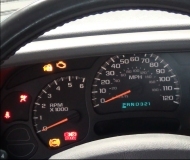The P108 means the MAP sensor voltage is too high. That sensor is fed with 5.0 volts and 0.2 volts on the ground wire. Roughly speaking, the acceptable limits for its signal voltage is 0.5 to 4.5 volts. Anything above 4.5 volts is a defective state and will set that code. There's a number of ways for that voltage to go too high. The ground wire could be open, meaning broken. The sensor itself could be failing. Rather than being a simple mechanical sensor like a throttle position sensor, the MAP sensor has electronic circuitry inside that can fail resulting in that 5.0 volt signal. Finally, just unplugging the MAP sensor while the ignition switch is on will set that code. When it's unplugged, the signal voltage could "float" to some random value due to the Engine Computer circuitry it's connected to, and to prevent that, they use a real simple "pull-up" circuit to force the signal voltage to go to a defective condition so it will be detected. That pull-up circuit has no effect when the sensor is properly connected. The point is, you can disregard that code if someone was working under the hood and had to unplug that sensor, but given the history, I'd sooner suspect a wiring problem with that sensor.
A simple test is to turn on the ignition switch, then measure the voltages on the three MAP sensor wires while it's still plugged in. Only one should have 5.0 volts. If you find it on two, check the connector terminals for corrosion and to be sure they aren't stretched out. Your mechanic will get the same information with a scanner that displays live data. It will list the MAP voltage and corresponding vacuum reading. With the engine not running, that voltage will typically be near 4.2 volts and represents barometric pressure. Once the engine is running, that voltage should be somewhere near 1.0 volt to maybe 1.5 volts. If it stays closer to 4.2 volts, that represents wide-open-throttle and will result in a lot of fuel being dumped into the engine.
Besides just looking for the correct voltage readings, experienced engine performance mechanics observe how the MAP and oxygen sensors respond to other conditions they create such as a small vacuum leak. Things like that help them diagnose what's working properly and what needs further attention. To you and me the engine might seem to be running fine but they might pick up on things that are less than ideal.
One point of interest is that only one side of the engine is running too rich. A defective MAP sensor reading will affect both sides of the engine equally. That suggests something other than, (or in addition to), a sensor problem is occurring. There is a tuning valve in the intake manifold that changes the length of the passages under certain driving conditions for better performance. That valve can cause a vacuum leak to affect one side of the engine more than the other side. That might explain why just one bank is affected. A misfire on just one cylinder will also affect that side of the engine only. Misfires can be subtle enough that we don't really feel them but the incomplete burning of the mixture results in unburned oxygen being detected by the oxygen sensor, telling the computer more fuel is needed for that entire side of the engine. The computer can determine which cylinder is misfiring by knowing the position of the crankshaft when its rotational speed slows down just a little. It's that same slowdown that causes us to feel a misfire. Since there hasn't been a misfire fault code set, that could suggest incomplete combustion instead of simply no combustion taking place in one or multiple cylinders. The result is the same; unburned oxygen detected in the exhaust system on one side of the engine.
Wednesday, June 13th, 2012 AT 9:55 PM



